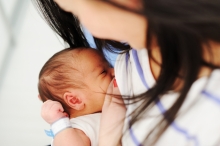Bacteria can store extra resources for the lean times. It’s a bit like keeping a piggy bank or carrying a backup battery pack. One important reserve is known as cyanophycin granules, which were first noticed by an Italian scientist about 150 years ago. He saw big, dark splotches in the cells of the blue-green algae (cyanobacteria) he was studying without understanding either what they were or their purpose.


Bacteria that move around live on the edge. All the time. Their success, be it in finding nutrients, fending off predators or multiplying depends on how efficiently they navigate through their confining microscopic habitats. Whether these habitats are in animal or plant tissues, in waste, or in other materials.

The cocktail of beneficial bacteria passed from mother to infant through breast milk changes significantly over time and could act like a daily booster shot for infant immunity and metabolism.
Researchers at McGill University have discovered bacterial organelles involved in gene expression, suggesting that bacteria may not be as simple as once thought. This finding could offer new targets for the development of new antibiotics.
The study, published in Proceedings of the National Academy of Sciences, is the first to show that E. coli uses similar strategies to regulate gene transcription as other more complex cell types.

New research spearheaded by McGill University has discovered that bacteriophages (viruses that infect bacteria) found in the intestinal tracts of children may play a role in childhood stunting, a significant impediment to growth that affects 22% of children under the age of five around the world.

Lorsqu’une contamination bactérienne se déclare à proximité d’une ferme, il faut cibler le plus rapidement possible les élevages problématiques puisque certaines souches peuvent parfois infecter l’homme. L’objectif est de mettre en place des barrières naturelles qui empêcheront les ruissellements provenant de ces fermes de se retrouver dans l’eau potable environnante.


Scientists at the University of Montreal and McGill University have pioneered and tested a new genomic methodology which reveals a complex bacterial ecosystem at work on the International Space Station.
Until now, relatively little was known about the different types of microbes found on the space station. The new approach enables researchers to identify and map different species inside the ISS, which will ultimately help safeguard astronauts’ health and be key to future long-term space travel.

A new type of “lab on a chip” developed by McGill University scientists has the potential to become a clinical tool capable of detecting very small quantities of disease-causing bacteria in just minutes.
The device designed by Sara Mahshid, Assistant Professor in the Department of Bioengineering at McGill, is made of nano-sized “islands,” about one tenth of the thickness of a single human hair, which act as bacterial traps or snares.

You are what you eat. Or so the saying goes. Science now tells us that we are what the bacteria living in our intestinal tract eat and this could have an influence on how well we age. Building on this, McGill University scientists fed fruit flies with a combination of probiotics and an herbal supplement called Triphala that was able to prolong the flies’ longevity by 60 % and protect them against chronic diseases associated with aging.

Highly complex interactions among roots, fungi and bacteria underlie the ability of some trees to clean polluted land, according to a novel study by bioinformatics and plant-biology experts from McGill University and Université de Montréal.
The list of “bad things” could range from gross but harmless spoilage to dangerous pathogens such as Clostridium botulinum. In the case of botulism, it’s the toxin produced from the bacteria that is harmful, not the bacteria itself, says Brigitte Cadieux, a postdoctoral fellow in McGill University’s Department of Food Science and Agricultural Chemistry.
Read more in the Globe and Mail


A concentrated extract of maple syrup makes disease-causing bacteria more susceptible to antibiotics, according to laboratory experiments by researchers at McGill University.
